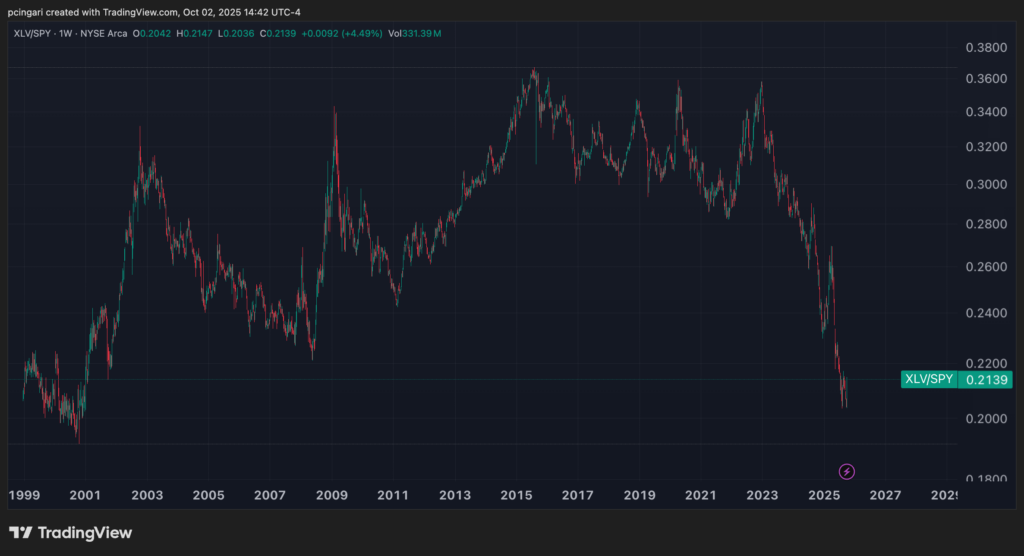
Health care stocks are on track for their best week in years, yet even after the rally, several pharma giants remain absurdly cheap by market standards.
The Health Care Select Sector SPDR Fund (NYSE:XLV) is up 4.5% this week through Thursday, pacing for its strongest weekly performance since June 2022.
The rally has been broad-based, with gains across large-cap pharmaceuticals, biotech and medical device companies — a sign that investor sentiment is shifting from skepticism to opportunity as tariff threats subside and pricing fears begin to normalize.
What Sparked The Health Care Turnaround?
Markets are responding to the recent deal between Pfizer Inc. (NYSE:PFE) and the Trump administration, which committed the drugmaker to providing most-favored-nation (MFN) pricing — essentially matching the lowest prices paid by other developed countries — but only for Medicaid sales, a relatively small slice of its revenue.
The agreement also includes a $70 billion investment in U.S. manufacturing and participation in the forthcoming TrumpRx.gov direct-to-consumer drug discount platform.
In return, Pfizer received a three-year reprieve from potential tariffs on branded drugs — a model that analysts expect other pharmaceutical companies may soon follow.
According to Goldman Sachs analyst Asad Haider, Pfizer’s deal “serves as a rough blueprint for the industry,” though he notes that each company will likely be evaluated on a case-by-case basis moving forward. He sees firms with diversified drug portfolios and strong new product cycles — such as Johnson & Johnson Inc. (NYSE:JNJ), Eli Lilly and Co. (NYSE:LLY), and Amgen Inc. (NYSE:AMGN)— as best positioned to negotiate favorable deals.
On the flip side, companies with outsized exposure to Medicaid, such as Gilead Sciences Inc. (NASDAQ:GILD), may face more headwinds.
Why It Matters: Valuation Gap Still Wide
Before this rebound, health care stocks were underperforming at a historic rate.
The XLV/SPDR S&P 500 ETF Trust (NYSE:SPY) ratio dropped to 0.2050 in late September — the lowest since December 2000.
The sector posted relative losses to the S&P 500 of 19.2% in 2023 and 18.2% in 2024, and remains 9 percentage points behind the broader index so far in 2025.

Even after this week's rally, the sector remains undervalued.
According to Goldman Sachs’ Haider, health care stocks are trading at a 30% discount to the S&P 500, compared to a historical average discount of 18%. Before the Pfizer deal, the discount had stretched to 38%, driven in part by fears of broad-based MFN pricing rules — what the analyst described as the “MFN-gap.”
Haider said the narrowing of this discount “suggests the sector broadly should trade at a more normal historical valuation discount” as investors grow more confident that drug pricing risks will be contained within specific agreements rather than applied industry-wide.
These 3 Mega-Cap Pharma Stocks Are Still Dirt Cheap
Despite the rally, three of the largest U.S. pharmaceutical companies are still trading at forward price-to-earnings (P/E) ratios below 10 — a rare valuation level in today’s market.
- Pfizer Inc. (NYSE:PFE): 9.6x
- Merck & Co., Inc. (NYSE:MRK): 9.7x
- Bristol-Myers Squibb Co. (NYSE:BMY): 7.2x
For context, the market-cap weighted forward P/E of the 60 stocks in the XLV ETF is now 21x, nearly 40% lower than the S&P 500's current forward P/E of 34.7x.
The valuation gap, combined with signs of stabilizing policy risk, is drawing investor attention back to big pharma — and for good reason.
Read Next:
Photo: FOTOGRIN/Shutterstock







